Astronomy in Korea
Astronomy in Korea
20th Century and Beyond History
History of Modem Astronomy in Korea
1910-1945
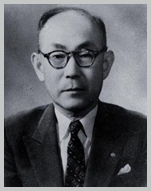 ▲ Dr. Won-Chul Lee
▲ Dr. Won-Chul Lee
It was only in the late 1950s that modern 20th century astronomy began to develop in earnest in Korea, as universities began to be organized following the country’s liberation from colonialism in 1945 and the Korean War in 1950. However, even during the period of Japan’s colonial rule, efforts at astronomical education were not entirely absent within Korea. In 1915, at the time of the opening of private Yonhi College by Christian missionaries which was the predecessor of today’s Yonsei University, Dr. Carl W. Rufus from the United States installed a course in astronomy within the department of mathematics and physics, thus offering an opportunity for study of astronomy within Korea.
A particularly notable figure in this emerging field was Dr. Won-Chul Lee (1896-1963) who was the first Korean to earn a doctorate in the natural sciences. He completed the course in astronomy at Yonhi College, and proceeded to earn his doctorate degree in astronomy abroad at Michigan State University in 1926. Later, Lee repatriated and taught mathematics and astronomy at his alma mater.
Due to the Japanese colonial regime’s policy of denying education to Koreans in the fields of advanced technology or science, the imperial Kyungsung University, the predecessor of today’s Seoul National University did not even have a college for science and engineering until 1938, when in the context of preparation for World War II, the university was finally allowed to establish a division for science and engineering studies.
1950-1970
In light of this historical context, the founding of the Department of Astronomy and Meteorology within the College of Liberal Arts and Sciences at Seoul National University in 1958 despite the hardships in the wake of the Korean War can be regarded as the true initiation of astronomy in Korea. Furthermore, the Korean Astronomical Society was established in 1965, in celebration of the vernal equinox day, which was followed by the launching of the Earth Science Education Research Society (the predecessor of today’s Korean Earth Science Society) in the same year. Also, in 1968, Yonsei University established its own Department of Astronomy and Meteorology, thereby carrying on the tradition of its predecessor, Yonhi College.
1970-1990
Around this period, Korea recognized the need for an observatory equipped with a telescope to support astronomical research and education, and construction began in 1972. As an official measure, the Ministry of Science and Technology announced the establishment of the National Observatory under a Presidential Decree in 1974. The completion of the Sobaeksan Optical Astronomy Observatory in 1978 came with the installation of a 61 cm reflecting telescope.
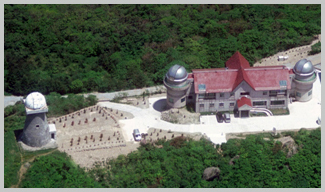 ▲ Sobaeksan Observatory
▲ Sobaeksan ObservatoryAlso, in 1985, Korea’s first radio astronomy observatory equipped with a 14m diameter radio telescope was established in the Daedeok Research Complex located in the city of Daejeon, making it possible to conduct research using radio waves in the millimeter band.
 ▲ Daedeok radio telescope
▲ Daedeok radio telescope In the 1980s, in accordance with the governmental policy of pursuing advancement in the field of astronomy and space sciences as well as the mid- and long-term national plans for promoting space science technology, Korea’s astronomical community expanded notably in scale. The result was such that Department of Astronomy and Space Science was established in Kyunghee University and Department of Earth Science which later became Department of Astronomy and Space Science in Sejong University respectively in 1985, and Department of Astronomy and Meteorology which later became Department of Astronomy and Atmospheric Sciences in Kyungpook National University and Departments of Astronomy and Space Science in Chungnam National University as well as in Chungbuk National University respectively in 1988.
1990-2010
In 1994, the Korean Space Science Society was founded with the aim of pursuing the advancement, application and promotion of space science as well as contributing to the progress of science. One year later, 1995 saw the completion of the Bohyeonsan Observatory, construction for which had begun much earlier, in 1985. The 1.8m reflecting telescope owned by the Bohyeonsan Observatory still claims the status of Korea’s largest telescope, and continues to make significant contributions to astronomical research in Korea.
From the late 1990s, energized by rising popular interest in science, Korea opened about 50 observatories catering to the public, including the Jungmisan observatory, which offers children various hands-on experiences along with a 14 inch telescope, and the Byeolmaro Observatory equipped with an 80cm telescope and an educational center.
In the meantime, the institution of the National Observatory itself has transformed into the Korea Astronomy and Space Science Institute (KASI) in 1999 after going through changes in its official name and status several times.
In 2001, in order to overcome the impediments of Korea’s climate, which is unfavorable for astronomical observation, KASI initiated the project of installing a 1 m optical telescope equipped with a remote observation system at Mt. Lemmon in Tucson, Arizona in the United States. After test operations over the course of one and half year, this telescope made it possible to secure high-quality astronomical observation data from even within Korea. In 2002, Seoul National University’s radio astronomical observatory, the second radio observatory in Korea, opened with a 6 m telescope.
Another milestone in radio astronomy research was initiated in 2004 with the starting of construction of the Korean VLBI Network (KVN), which was subsequently completed in 2008. The KVN is capable of generating the effect of a radio telescope with 500km diameter through simultaneous operation of three 21m telescopes located in Seoul (Yonsei University), Ulsan (University of Ulsan), and Jeju (Tamna University). In addition to precise measurement of the location of celestial bodies and studies of star formation and evolution using masers, this system will be used to study gravitational lenses and ultra micro-scale structures such as active galactic nuclei, and to detect tiny crustal movements on the Korean Peninsula. Furthermore, the completion of the East Asia VLBI Network (EAVN), which is to link up with radio telescopes in Japan and China, will produce the effect of an enormous radio telescope with a 5,000km aperture.
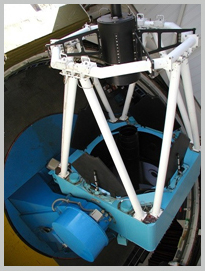 ▲ Bohyeonsan telescope
▲ Bohyeonsan telescope 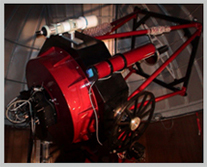 ▲ Mt. Lemmon telescope
▲ Mt. Lemmon telescope 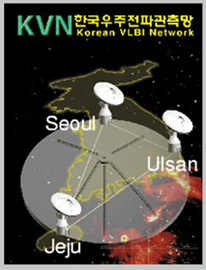
Besides the ground based observations, space based astronomical research also got started in late 1990’s along with the development and launch of scientific satellites involving Korea Aerospace Research Institute(KARI) and Korea Advanced Institute of Science and Technology (KAIST). The high energy particle detectors and thermal electron measurement sensors onboard the Korean Institute of Technology Satellite-3 (KITSAT-3) and the Korean Multi-purpose Satellite-1(KOMPSAT-1), both of which were launched in 1999 were used to study the plasma environment and its impact during the solar maximum. In addition, advanced scientific payloads including the Far Ultra-violet Imaging Spectrograph(FIMS) were developed for the Science and Technology Satellite-1(STSAT-1) launched in 2003. FIMS was able to detect emission lines from hot interstellar matter such as supernova remnants and galactic coronas, making significant contributions to the study of galactic evolution. Furthermore, The STSAT-3 scheduled to be launched in late 2012 will provide astronomical infrared imagery of galaxies and of the cosmic background using MIRIS (Multi-purpose Infrared Imaging System). Meanwhile, the membership of the Korean Astronomical Society, which initially had 20 members at the time of its founding, has rapidly increased to almost 600 members by 2008.
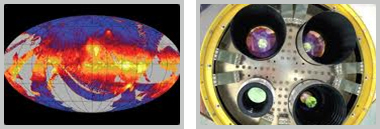 ▲ FUV map of our galaxy by FIMS onboard STSAT-1
▲ FUV map of our galaxy by FIMS onboard STSAT-1 Beyond 2010
In 2009, the Korean Microlensing Telescope Network (KMTnet) project was initiated and will continue through 2018. Three identical 1.6m telescopes with large field-of-view cameras will be constructed and deployed in the southern hemisphere in three different time zones (Cerro Tololo Inter-American Observatory (CTIO), Chile; South Africa Astronomical Observatory (SAAO), South Africa; and Siding Spring Observatory (SSO), Australia), providing 24 hour monitoring of gravitational microlensing events. It is expected that KMT will increase the planet detection rate by an order of magnitude and yield the demographics of Earth-mass planet populations throughout the Galaxy.
Since 2009, the Korea Astronomy and Space Science Institute has joined an international consortium to develop the Giant Magellan Telescope(GMT), which will rival the capacity of a telescope with a single 24.5m primary mirror and produce images up to 10 times sharper than the Hubble Space Telescope. Once this telescope is completed in 2018, Korea will be able to use it for one month each year, which is anticipated to bring about a new remarkable growth of astronomy in Korea.
 ▲ KMTnet network
▲ KMTnet network(In South America, CTIO was later chosen
instead of Las Campanas.)
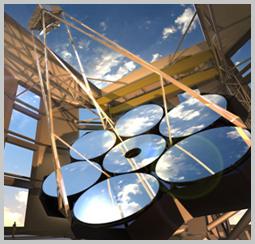 ▲ Giant Magellan Telescope(GMT)
▲ Giant Magellan Telescope(GMT) Milestones
1915 :
Upon the opening of Yonhi College, Dr. Carl W. Rufus installs a course on astronomy within the department of mathematics and physics.
1926 :
Dr. Won-Cheol Lee becomes the first Korean to earn a doctorate degree in the natural sciences for his research in astronomy.
1958 :
Seoul National University establishes the Department of Astronomy and Meteorology.
1965 :
The Korean Astronomical Society is established on vernal equinox day.
1965 :
The Earth Science Education Research Society is launched.
1968 :
Yonsei University establishes Department of Astronomy and Meteorology.
1974 :
The Ministry of Science and Technology establishes the National Observatory according to a Presidential Decree.
1978 :
The completion of a 61 cm reflecting telescope at the Sobaeksan Observatory.
1985 :
The 14m Daedeok Radio Astronomy Observatory, Korea’s first cosmic radio observatory, is established in the Daedeok Research Complex in Daejeon.
1985 :
Kyunghee University installs Department of Space Science.
1985 :
Sejong University establishes Department of Earth Science
1988 :
Kyungpook National University establishes Department of Astronomy and Meteorology.
1988 :
Chungnam National University establishes Department of Astronomy and Space Science.
1988 :
Chungbuk National University establishes Department of Astronomy and Space Science.
1994 :
The Korean Space Science Society is founded.
1996 :
The completion of the 1.8m reflecting telescope installed in Mt. Bohyeonsan.
1999 :
The plasma environment of the Earth during the solar maximum is observed by scientific satellites, KITSAT-3 and KOMPSAT-1.
2001 :
The Korea Astronomy and Space Science Institute installs its 1m optical telescope in the Mt. Lemmon Observatory, located in Tucson, Arizona in US.
2002 :
The opening of Seoul National University’s radio astronomy observatory.
2003 :
FIMS onboard STSAT-1 satellite makes observation of our galaxy in FUV.
2008 :
The completion of the Korean VLBI Network (KVN).
2009 :
The Korean Microlensing Telescope Network (KMTnet) project is initiated.
2009 :
The Korea Astronomy and Space Science Institute joins the project to develop the Giant Magellan Telescope(GMT).
2012 :
MIRIS is developed as payload for STSAT-3 to get IR images of galaxies and the cosmic background.